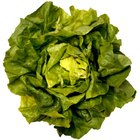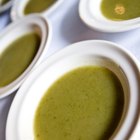
Brand X Pictures/Brand X Pictures/Getty Images
Pico de gallo is a basic salsa that's made with a variety of vegetables and fruits, such as onions, jalapeno peppers, tomatoes, cilantro, lime juice and garlic. It blends well with scrambled eggs, salads, baked tortilla chips, fish and chicken. This light salsa contains approximately 6 calories and less than 1 gram of fat per 1-ounce serving, which makes it a welcome addition to calorie-conscious dits. Consume pico de gallo regularly to enjoy a wealth of health benefits.
Antioxidant-Rich
Pico de gallo is packed with antioxidants, which fight the harmful free radicals that cause cellular mutations. This damage, called oxidative stress, also contributes to the development of chronic health conditions. The antioxidants in onions and garlic include organosulfur and allicin, which are compounds that help combat disease, such as atherosclerosis, and supply the potent aroma in these vegetables. The antioxidants in tomatoes include vitamin C, vitamin E and lycopene. Lycopene is a carotenoid that provides the red pigment in tomatoes and helps protect the body against prostate, urinary, intestinal and some stomach cancers. Cilantro contains a plethora of antioxidants, including gallic acid, caffeic acid, ferulic acid and chlorogenic acid, which may combat cancer cells and increase insulin sensitivity among diabetics, suggests a study published in 2005 in the “International Journal of Food Sciences and Nutrition.”
Blood Thinner
The onions and garlic in pico de gallo act as blood thinners that may assist in protecting your body against heart disease, notes the Department of Foods and Nutrition at the University of Georgia. In addition, these vegetables can help prevent the formation of blood clots that can cause a stroke or heart attack. Consuming garlic and onions may help you lower your bad cholesterol and increase your good cholesterol, further decreasing your risk of heart disease.
Anti-Inflammatory
Pico de gallo contains vegetables that may decrease inflammation. Garlic and onions contain anti-inflammatory properties that may diminish symptoms of asthma, arthritis and cardiovascular disease. Jalapeno peppers contain an anti-inflammatory agent called capsaicin, which may help individuals with arthritis by increasing circulation and releasing endorphins to relieve pain. In addition, an animal research study published in January 2012 in the “Journal of Ethnopharmacology” suggests that the ethanol and butanol extracts in capsaicin decrease inflammation and oxidative stress in chronic inflammatory conditions.
Antibacterial Agent
Consuming pico de gallo may provide your body with antibacterial properties. Garlic and onions contain antibacterial agents that may assist in protecting against certain bacteria that cause stomach ulcers. Furthermore, cilantro contains oils with bacteria-fighting agents that are effective against Listeria monocytogenes, a food-borne bacterium that can cause nausea, vomiting, diarrhea and other flu-like symptoms, according to a study published in 2001 in the “International Journal of Food Microbiology.”
Related Articles

Food Sources of Betaine

Nutritional Benefits of Butter Leaf ...

What Makes Pico de Gallo Taste Bitter?

Foods That Are Good for Arthritis Pain ...

What Are the Health Benefits of Cooked ...

Nutrition Information on Blueberries

Vitamins for Mental Alertness

Foods That Are Natural Antibiotics

The Spices in Pad Thai

Uses of Saltpeter in Food

What Are the Health Benefits of ...

Are Bean Sprouts Good for You?

The Best Spices for Soups

Which Vegetables Produce the Most ...

How to Make Cucumber Kimchi

How to Make Fish Taco Sauce

How to Get Rid of Garlic Body Odor

How to Use Garbanzo Beans As a Meat ...

A List of Foods That Contain Choline

Avocado Serving Size & Nutrition
References
- Department of Foods and Nutrition, University of Georgia: Garlic and Onions
- International Journal of Food Microbiology: Antimicrobial Activity of Individual and Mixture Fractions of Dill, Cilantro, Coriander and Eucalyptus Essential Oils
- International Journal of Food Sciences and Nutrition: Antioxidant and Free Radical Scavenging Activities of Some Leafy Vegetables
- ScienceDaily: What Makes Peppers Hot May Also Be Cool for What Ails You
- Journal of Ethnopharmacology: Antioxidant and Anti-Inflammatory Properties of Capsicum Baccatum: From Traditional Use to Scientific Approach
Writer Bio
Suzanne Allen has been writing since 2004, with work published in "Eating for Longevity" and "Journal of Health Psychology." She is a certified group wellness instructor and personal trainer. Allen holds a Bachelor of Arts in communication and information sciences, a Bachelor of Arts in psychology and a Master of Arts in clinical psychology.
Photo Credits
Brand X Pictures/Brand X Pictures/Getty Images